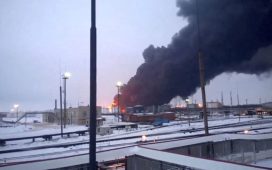(Reuters) – A trio of wintry storms headed across the United States during the busy Thanksgiving travel period could mean jitters or joy for more than 55 million people on the roads, rails, waterways and in the air.
The first of three storms predicted for the holiday week was headed for the U.S. Northeast on Sunday, with overnight accumulations of 4 to 7 inches of snow expected to make driving hazardous in northern New Hampshire and central and northern Maine, said National Weather Service meteorologist Patrick Burke at the Weather Prediction Center in College Park, Maryland.
That storm was expected to end by early Monday.
A second, smaller storm was predicted to aim a snowball at the Midwest on Tuesday, where 3 to 6 inches of snow was expected to pile up in Denver, Minneapolis, Omaha, and Des Moines, as well as parts of Wisconsin.
The third is a massive soggy system set to drench the parched West Coast, making its way on Wednesday from the Pacific Northwest to southern California, where it will sit until Friday, lolling like an over-stuffed holiday guest.
“This is a pretty powerful one, right over the holiday,” Burke said.
This year is expected to mark the second-highest travel volume for America’s busiest holiday, trailing the record set in 2005, said the American Automobile Association (AAA).
Airports will see 26.8 million passengers traveling through security screening checkpoints nationwide, said Transportation Security Administration (TSA) officials.
“Nothing worse than Wednesday,” AAA said, expecting a travel crush on Nov. 27, the day before the federal holiday that has taken place on the fourth Thursday in November since 1942.
Wicked weather for travelers could mean snowy slopes for outdoor enthusiasts, however.
“It’s going to deliver quite a bit of snow to some of the ski resorts,” Burke said of the storm system headed for the West Coast.
“Once it gets into southern California, it just really sets up there for a prolonged period of widespread rainfall and heavy mountain snow affecting not just California but much of the southwestern U.S., including parts of Arizona, Nevada, Utah.”
Reporting by Barbara Goldberg; Editing by Sonya Hepinstall








